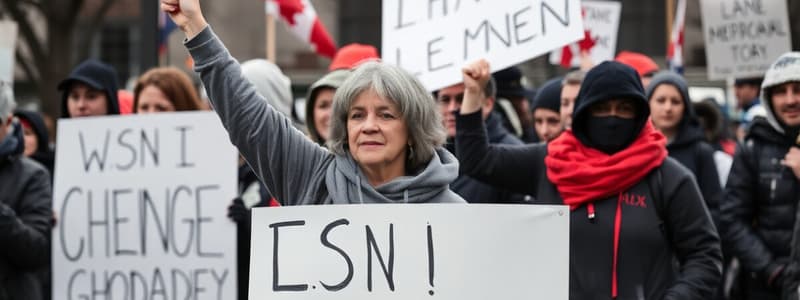Podcast
Questions and Answers
In liberal-democratic societies, what fundamental tension arises when policing political dissent?
In liberal-democratic societies, what fundamental tension arises when policing political dissent?
- Harmonizing international human rights obligations with domestic laws concerning assembly.
- Mediating between the economic interests of corporations and the environmental concerns of protesters.
- Reconciling the protection of political dissent as a fundamental value with the potential criminalization of dissenting acts. (correct)
- Balancing the need for absolute freedom of expression with the state's interest in maintaining public order.
Which approach to policing protests emphasizes cooperation and mutual understanding between police and protesters, often involving permits and negotiations?
Which approach to policing protests emphasizes cooperation and mutual understanding between police and protesters, often involving permits and negotiations?
- Strategic incapacitation
- Negotiated management (correct)
- Escalated force
- Preventative policing
What is a key characteristic of strategic incapacitation as an approach to policing protests?
What is a key characteristic of strategic incapacitation as an approach to policing protests?
- The use of overwhelming force to immediately disperse protesters.
- Ignoring minor infractions during protests to maintain a peaceful environment.
- Permit-based negotiation with protest organizers to manage demonstrations.
- Targeting and removing strategic 'nodes' such as protest organizers through various tactics. (correct)
How does a critical criminology perspective view the policing of protests, particularly concerning economic interests?
How does a critical criminology perspective view the policing of protests, particularly concerning economic interests?
What is the main goal of Project SITKA?
What is the main goal of Project SITKA?
What is the issue with policing actions?
What is the issue with policing actions?
Why might activists intentionally seek arrest during protests?
Why might activists intentionally seek arrest during protests?
What distinguishes reactionary social movements from progressive ones?
What distinguishes reactionary social movements from progressive ones?
How do authoritarian societies typically respond to public dissent?
How do authoritarian societies typically respond to public dissent?
What is the significance of the Canadian Charter of Rights and Freedoms in the context of political dissent?
What is the significance of the Canadian Charter of Rights and Freedoms in the context of political dissent?
Why is the criminalization of dissent considered a puzzle in liberal-democratic states?
Why is the criminalization of dissent considered a puzzle in liberal-democratic states?
What does the term 'escalated force' refer to in the context of policing protests?
What does the term 'escalated force' refer to in the context of policing protests?
In the context of policing protests, what does 'strategic incapacitation' primarily involve?
In the context of policing protests, what does 'strategic incapacitation' primarily involve?
What is the purpose of creating risk profiles of activists, as seen in projects like SITKA?
What is the purpose of creating risk profiles of activists, as seen in projects like SITKA?
How can laws be used to curtail dissent during protests?
How can laws be used to curtail dissent during protests?
What is the potential consequence of the wide latitude given to police in determining what conduct is allowed or unallowed during protests?
What is the potential consequence of the wide latitude given to police in determining what conduct is allowed or unallowed during protests?
What does a governmentality approach focus on in the context of policing protests?
What does a governmentality approach focus on in the context of policing protests?
How has breaking the law played a role in the history of political activism?
How has breaking the law played a role in the history of political activism?
What does the example of Jaggi Singh's arrest illustrate about the strategic incapacitation of protesters?
What does the example of Jaggi Singh's arrest illustrate about the strategic incapacitation of protesters?
What does the text say about the rights that people currently have?
What does the text say about the rights that people currently have?
Flashcards
Political Dissent
Political Dissent
The freedom to associate, assemble, and express political views, crucial in a liberal-democratic society.
Criminalization of Dissent
Criminalization of Dissent
The act of making dissent illegal, limiting the ability to assemble and express political views.
Social Change
Social Change
Challenging existing cultural and political norms to address injustices and power imbalances.
Escalated Force
Escalated Force
Signup and view all the flashcards
Negotiated Management
Negotiated Management
Signup and view all the flashcards
Strategic Incapacitation
Strategic Incapacitation
Signup and view all the flashcards
Tactical Innovations of Strategic Incapacitation
Tactical Innovations of Strategic Incapacitation
Signup and view all the flashcards
Project SITKA
Project SITKA
Signup and view all the flashcards
Critical Criminology Perspective
Critical Criminology Perspective
Signup and view all the flashcards
Actuarial/Governmentality Approach
Actuarial/Governmentality Approach
Signup and view all the flashcards
Study Notes
- Acknowledging the purpose of policing priorities and what could be at risk is crucial.
- Dissent is against the law in some countries, this includes political assembly and expressing political views.
- The Canadian Charter of Rights and Freedoms is the foundation of Canadian society.
- The freedom to associate, assemble, and express political views is taken seriously in Canada.
- Protests and social movements fought for the rights that are now taken for granted.
- To make a statement, big and sometimes illegal acts were done.
- Some activists would get arrested to challenge the law.
- Political activism and the rights enjoyed today were achieved partly by breaking the law.
- These rights are not permanent and can be reduced or removed.
- Social change can be progressive, radical, or revolutionary, changing society and culture to address existing power imbalances.
- Dissent can be criminalized.
- Laws can be used to curtail dissent when dealing with protests.
- Jaggi Singh, a Canadian activist, was arrested for allegedly attacking a police officer with a megaphone.
- The charge was likely a way to remove Singh from the streets during a politically sensitive time, using incapacitation to silence him temporarily.
Empirical Research Methods
- Information for claims comes from empirical research methods.
Learning Objectives
- Recognizing political dissent as a fundamental value in a liberal-democratic society, and understanding the tension this creates with policing.
- Track the historical development of approaches to policing protest, from escalated force to strategic incapacitation.
- Contrasting strategic incapacitation with alternative approaches and characterizing it regarding key features.
- Situating the police regarding debates over their role in society, and whose interests they represent.
Dissent
- Public dissent poses a fundamental challenge to state power in authoritarian societies, leading to imprisonment, torture, and death.
- Canadian society is based around the protection of fundamental freedoms which includes the freedom to think differently, associate, assemble, and express views, including political dissent.
- Those engaged in political dissent may face reprisals in democracies, ranging from discriminatory policing to detainment, surveillance, espionage, and criminal prosecution.
- Criminalizing dissent in liberal-democratic states raises questions about its legitimacy.
Unlawful Acts of Protest
- Social movements' unlawful acts of protest have contributed to securing important human rights around the world, including gender and racial equality.
- Social activism is rarely considered a criminal act, however, throughout modern history, acts of political dissent have commonly been treated as criminal and deviant.
- Challenges to traditional cultural and political ideas and policies with the aim to promote social change to address problems of injustice, economic power imbalances, and social inequalities can be considered radical or revolutionary.
- Reactionary movements support traditional social systems against progressive change or a perceived threat to the existing social order.
Policing Protest
- Policing protest can range from escalated force to negotiated management.
- Escalated force is a force-based and confrontational model of protest policing, popular in the 1960s and early 1970s.
- Negotiated management involves permits and negotiation, with cooperation and mutual understanding between police and protesters.
- Protesters in the 1980s adopted the negotiated management approach, preferring to work with police and have a seat at the table and the professionalization of protest is the right way to protest.
Strategic Incapacitation
- Radical social movement organizations and new, repressive policing forms have emerged due to negotiated protests being perceived as pointless.
- Attempts to target and eliminate/remove strategic nodes like protest organizers.
- Strategic incapacitation involves tactical innovations aimed at temporarily incapacitating transgressive protesters.
- These tactics include no-protest zones, increased use of less-lethal weapons, strategic arrests, and surveillance and infiltration of movement organizations.
- There is an emphasis on risk management and the prevention of crime and disorder.
- Intelligence gathering, risk assessment, disruption, and prevention are key components.
Project SITKA
- Project SITKA was a secret quasi-criminal investigation (2014-2015)
- The RCMP collected information from its databases to identify and track Indigenous protesters.
- 313 individuals opposing natural resource development, particularly pipeline and shale gas expansion, were identified (also MMIWG).
- 89 individuals were found to meet the criteria for criminality and had profiles created about them, but were not criminally charged.
- It is an example of public order policing informed by a strategic incapacitation approach.
- Emphasis is placed on surveillance and building of risk-profiles, targeting activist groups and individuals.
- Justified as a way to target criminality in otherwise lawful protests, but ends up profiling activists more generally and carrying out risk assessments based on how "successful" activists might be in promoting social change.
Conclusion
- Protests, including disruptive ones, are legally protected in Canada and are important for democracy, but many protest actions are arguably illegal or criminal.
- This gives police wide latitude in drawing lines between allowed and unallowed conduct.
- Targeting protesters serves specific interests, such as those of the extractive industry in places like Fairy Creek and Wet'suwet’en territory.
- Critical criminology sees this kind of policing as reinforcing the dominant economic order and protecting Canada’s status quo as an extractivist settler colony.
- Governmentality approaches focus on specific techniques and ways of understanding protest by government as risks to be managed, contained, and demobilized.
Studying That Suits You
Use AI to generate personalized quizzes and flashcards to suit your learning preferences.




